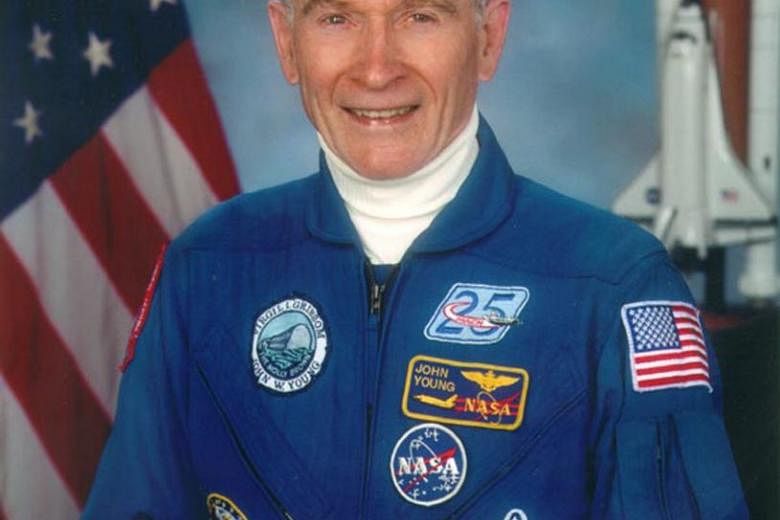WASHINGTON (BLOOMBERG) - John Young, one of only 12 humans to walk on the moon and commander of Nasa's first space shuttle mission, has died. He was 87.
He died on Friday (Jan 5) following complications from pneumonia, according to a statement from the US National Aeronautics and Space Administration.
The agency didn't say where he died.
The longest-serving astronaut in the space programme, Young's career began as a Navy test flier. He was the only moon walker to pilot a space shuttle, the first person to go into space six times and the only one to fly and command four types of spacecraft - Gemini, Apollo, lunar module and shuttle.
"Nasa and the world have lost a pioneer," Robert Lightfoot, Nasa administrator, said in the statement. "Astronaut John Young's storied career spanned three generations of spaceflight; we will stand on his shoulders as we look toward the next human frontier."
Young's achievements were paired with a laconic style and a heartbeat that barely jumped after liftoff. He was a stickler for safety, which benefited and exasperated Nasa officials.
"He was quite an asset to the space programme," Apollo 13 commander Jim Lovell said, according to an interview with the Orlando Sentinel when Young retired in 2004.
"He was always questioning what we were doing and why we were doing it."
Young joined Nasa in 1962. His earliest voyage into space was on Gemini 3, the agency's first two-man flight, commanded by Virgil "Gus" Grissom, in 1965.
LUNAR PRELUDE
The next year, on Gemini 10, Young and Mike Collins completed a dual docking and other maneuvers as prelude to the Apollo programme's quest to put a man on the moon.
On Apollo 10, in May 1969, Nasa performed what it called "a full dress rehearsal" for landing men on the moon two months later.
Young remained in the command capsule as Thomas Stafford and Eugene Cernan descended in a lunar module to within 14km of the moon's surface. Returning to Earth, they set a record still not equalled by a manned vehicle, going 32 times the speed of sound, or almost 40,000kmh.
In April 1972, aboard Apollo 16, Young became the ninth member of the exclusive club of moon walkers. Bouncing along the lunar surface in a four-wheeled rover, he and Charlie Duke collected 90kg of rock specimens.
Once the US had beaten the Soviet Union's cosmonauts to the moon and funding dried up, Young pushed Nasa to return to the moon or venture to Mars, to provide the human race with a backup home in the event of Earth's destruction.
DIRE OUTLOOK
"Earth's geologic history is pretty clear: It says, quite frankly, that single-planet species don't last," Young said, according to a 2004 Houston Chronicle story.
Young became chief of Nasa's Astronaut Office, supervising training of new recruits and helping to develop the shuttle, the first fixed-wing space vehicle designed for reuse.
In 1981, Young commanded the shuttle programme's inaugural mission, orbiting Earth 37 times in the Columbia. It was the first time Nasa put men on a vehicle's initial voyage, and the earliest manned spacecraft launched by solid rocket boosters.
He commanded the Columbia again in 1983, his final journey into the cosmos.
Young already had a history of acting as a watchdog for crew safety and firing off blunt memorandums when the Challenger exploded shortly after takeoff in January 1986, killing all seven aboard. A memo he had sent three weeks earlier, leaked to the media after the tragedy, criticised Nasa for compromising protection to meet launch schedules.
SHUTTLE WARNINGS
In news interviews and testimony to the presidential commission that investigated the accident, he warned that space shuttles would continue to reveal defects.
"The technical truth always has to be told, and telling it regardless of the consequences was one of my personality traits that people who knew me well learned to put up with," Young wrote in Forever Young, his 2012 autobiography.
Young was reassigned in 1987 as special assistant for engineering, operations and safety at the Johnson Space Center in Houston, a move he viewed as punishment for his outspokenness.
"I wrote my memos to hit people over the head: with facts, with what-ifs, with contingencies, with options to contingencies, and with the stupidity and danger of absurd and ludicrous bureaucratic decisions," Young wrote about the 2003 loss of the shuttle Columbia and seven more lives.
"In retrospect, it's just so damn hard to believe that we hadn't pinpointed the problem."
TEST PILOT
John Watts Young was born Sept 24, 1930, in San Francisco to William Young and Wanda Howland Young. The family moved to Cartersville, Georgia, and then Orlando, Florida, as his father sought work during the Depression.
Young earned a bachelor's degree in aeronautical engineering from the Georgia Institute of Technology in Atlanta in 1952. He was an aviator in the Korean War and remained in the Navy as a test pilot until joining the astronaut corps.
Even after he was moved to a desk job, Young kept his credentials current and remained a qualified astronaut until retiring at age 74.
He acknowledged being haunted by the deaths of the two shuttle crews and of close friend Grissom, killed with two other astronauts in the 1967 fire during a test countdown for what was to have been Apollo 1.
"Even today, approaching a half century later, I swallow hard when I think back to the Apollo 1 fire and the deaths of our buddies," Young wrote in his memoir.
Young was married to the former Susy Feldman. With his first wife, Barbara White Young, he had two children, John Jr and Sandra.

